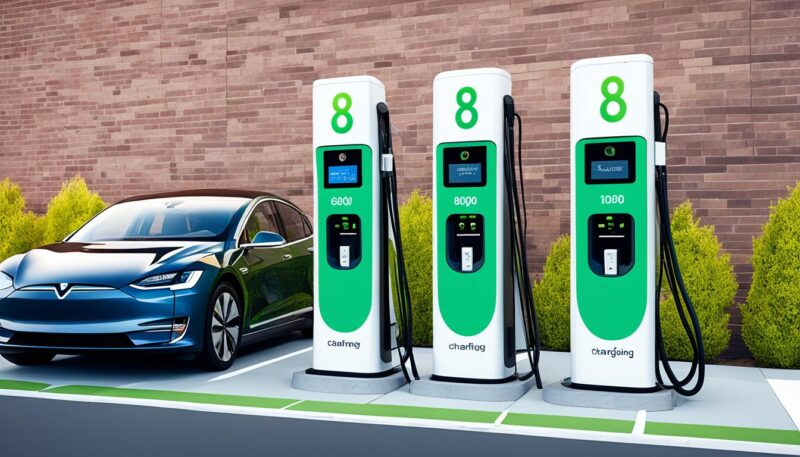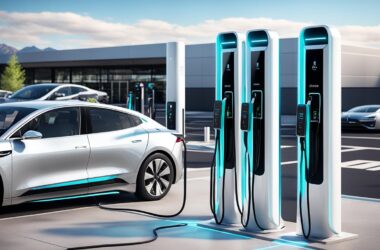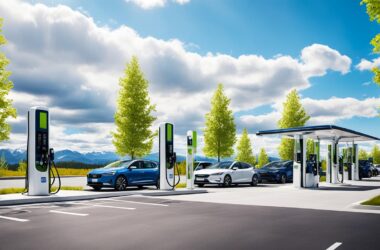When it comes to charging your electric vehicle (EV), you may have heard conflicting advice regarding the optimal charging level. Some say that charging up to 80% is the best practice to maintain battery health, while others argue that charging to 100% is necessary for maximum range. In this guide, I’ll debunk the myth of the 80/20 rule and provide clear recommendations for EV charging.
The myth of the 80/20 rule suggests that EV batteries should never be charged beyond 80% or discharged below 20% to avoid irreversible damage. However, this myth is based on misinformation and is not applicable to EVs. Most EV manufacturers recommend charging to 80% for normal day-to-day charging. Charging to 100% every time is unnecessary and can stress the battery.
Early EVs with smaller batteries were often charged to 100% without experiencing significant battery deterioration over time. Additionally, when using DC fast-chargers, it is more efficient to stop at 80% and charge for shorter durations. Going below 20% is also not recommended as it provides a reserve in case of detours or charger unavailability. However, the EV’s battery management system will provide warnings and prevent over-discharging. Overall, it is best to charge to 80% and avoid regularly going below 20% or charging to 100%.
Key Takeaways:
- Charging an EV to 80% is recommended for everyday use, as it balances battery health and range requirements.
- Charging to 100% every time is unnecessary and can stress the battery.
- Going below 20% regularly is not recommended as it can damage the battery, but the battery management system will provide warnings and prevent over-discharging.
- When using DC fast-chargers, stopping at 80% is more efficient and reduces charging time.
- Early EVs charged to 100% without significant battery deterioration, but modern EVs are optimized for charging to 80%.
Charging Frequency and Battery Health
When it comes to the longevity and health of your EV battery, charging frequency plays a crucial role. It is important to strike a balance between ensuring sufficient charge for your daily driving needs and avoiding unnecessary stress on the battery. Charging your EV to 80%, instead of 100%, is generally sufficient for most EV models and helps maintain battery health over the long term.
Early EVs with smaller batteries used to be charged to 100% without experiencing significant battery deterioration. However, with advancements in battery technology and the understanding of battery chemistry, it has been established that regular charging to 100% can be detrimental to the overall health of the battery.
Occasionally charging your EV to 100% when needed, such as before embarking on a long trip, will not irreparably damage the battery. This strategy allows you to make the most of your EV’s range without compromising its long-term health.
Charging frequency also depends on the availability of DC fast-chargers. It is worth noting that charging from 0% to 80% typically takes a similar amount of time as going from 80% to 100%. As a result, if you do not require that last 20% of charge for your upcoming journey, stopping at 80% and opting for shorter charging sessions can be more efficient and help preserve battery health.
By adopting a charging routine that prioritizes battery health and longevity, you can ensure that your EV consistently delivers optimal performance while minimizing the risk of premature battery degradation.
Benefits of Charging to 80%:
- Enhanced battery longevity
- Minimized risk of premature battery degradation
- Efficient use of charging time
- Optimal balance between range and battery health
Charging your EV to 80% ensures a balance between range requirements and battery health, promoting optimal longevity for your battery.
Understanding the relationship between charging frequency and battery health is essential for every EV owner. By following recommended charging practices and considering the availability of fast-charging infrastructure, you can maximize the performance and life of your EV battery.
Optimal Charging Levels for EV Batteries
When it comes to charging your EV battery, finding the optimal level is crucial for efficiency and longevity. Charging to the right level can help maximize your battery life and ensure optimal performance. So, what are the recommended charging levels for EV batteries?
“Charging to 100% every time is unnecessary and can stress the battery.”
For day-to-day charging, it is generally recommended to charge your EV battery to around 80%. This level provides a good balance between range and battery health. Going for the full 100% charge every time is not necessary and can put unnecessary stress on the battery, potentially leading to degradation over time.
Many EV manufacturers advise charging to 100% only when needed, such as before a long trip or when extra range is required. This approach ensures that you are not regularly subjecting your battery to extended periods at full charge, which can impact its overall lifespan.
“Going below 20% is not recommended as it can damage the battery.”
On the other end of the spectrum, letting your battery level drop below 20% is also not recommended. Going too low can damage the battery and may have an adverse effect on its performance and longevity. Manufacturers usually equip their EVs with warning systems and safeguards to prevent over-discharging, but it’s still best to avoid regularly pushing your battery to its lowest limits.
In summary, the optimal charging level for day-to-day driving is around 80%. Charging to 100% should be done only when necessary, and going below 20% should be avoided. By following these guidelines, you can help ensure the longevity and efficiency of your EV battery.
Benefits of Optimal Charging Levels
Charging your EV battery to around 80% offers several benefits:
- Improved Battery Life: By avoiding full charges and deep discharges, you can help extend the lifespan of your battery.
- Efficient Charging: Charging to 80% is generally faster than charging up to 100%, allowing you to spend less time at charging stations.
- Range Optimization: Charging to 80% provides a good balance between range and battery health, ensuring you have enough power for your daily driving needs.
- Battery Health Monitoring: By practicing optimal charging, you can better monitor and maintain your battery’s health over time.
Following these optimal charging levels will not only benefit your EV battery but also contribute to a more sustainable and efficient driving experience.
| Charging Level | Benefits |
|---|---|
| 80% |
|
| 100% |
|
| Below 20% |
|
EV Battery Chemistry Types
When it comes to EV batteries, there are different types of battery chemistries used in electric vehicles. The two most common types are NMC (nickel manganese cobalt) and NCA (nickel cobalt aluminum) lithium-ion batteries.
Lithium-ion batteries are recommended to be charged to around 80% for normal day-to-day charging. This charging level strikes a balance between battery longevity and providing sufficient range for everyday driving needs.
Another type of lithium-ion battery used in EVs is LFP (lithium-iron-phosphate) batteries. Unlike NMC and NCA batteries, LFP batteries use iron and phosphorus instead of nickel or cobalt. LFP batteries are cheaper to produce and are used by some manufacturers to reduce EV manufacturing costs and address concerns related to cobalt mining.
LFP batteries have slightly different charging characteristics compared to NMC and NCA batteries. In some cases, LFP batteries may be charged to 100% more regularly. However, it’s important to note that LFP batteries are less energy-dense and are not suitable for large battery packs that require high energy storage capacity.
Overall, the choice of battery chemistry depends on a range of factors, including cost, energy density requirements, and sustainability considerations. Manufacturers carefully select the battery chemistry that best meets the needs of their EV models and strikes a balance between performance, cost, and environmental impact.
Comparison of EV Battery Chemistries
| Battery Chemistry | Main Components | Charging Characteristics | Energy Density |
|---|---|---|---|
| NMC (Nickel Manganese Cobalt) | Nickel, Manganese, Cobalt | Recommended to charge to around 80% for day-to-day charging | High energy density |
| NCA (Nickel Cobalt Aluminum) | Nickel, Cobalt, Aluminum | Recommended to charge to around 80% for day-to-day charging | High energy density |
| LFP (Lithium-Iron-Phosphate) | Iron, Phosphorus | May be charged to 100% more regularly | Lower energy density, suitable for smaller battery packs |
EV Charging for Different Scenarios
When it comes to EV charging, the practices may vary depending on different scenarios. Two common scenarios are charging at home and charging at public stations, each with its own considerations and benefits.
Charging at Home
Charging at home offers EV owners more control and convenience over their charging process. By having a dedicated charging station at home, you can easily plug in your EV and let it charge overnight or during off-peak hours. This allows you to take advantage of lower electricity rates and ensures that your vehicle is ready for use the next day.
For day-to-day use, it is recommended to charge your EV battery to around 80%. This level strikes a balance between minimizing battery stress and meeting your range requirements. Charging to 80% on a regular basis is generally sufficient for most daily driving needs, providing you with a comfortable driving range while optimizing battery health.
By following this recommended charging level of 80% at home, you can ensure that you have enough range for your daily commute and errands, without unnecessarily stressing the battery or wasting energy by charging to full capacity.
Charging at Public Stations
Charging at public stations, especially those equipped with DC fast-chargers, offers the advantage of faster charging times compared to home charging. This is particularly useful when you’re on the go and need to quickly top up your battery’s charge.
When using public charging stations, it is still recommended to charge up to 80% in order to minimize charging time and maximize efficiency. By stopping at 80%, you can achieve a significant charge in a relatively short amount of time, allowing you to continue your journey with minimal disruption.
However, there may be instances where you require a longer range, such as when embarking on a road trip. In such cases, it is acceptable to charge to 90% or more occasionally, ensuring you have the necessary range to reach your destination or the next available charging point. Just be mindful not to leave your battery at 100% or let it sit at a high charge level for extended periods of time, as this can have a negative impact on battery health.
To summarize, charging practices for EVs vary depending on the scenario. Charging at home allows for control and convenience, with a recommended charging level of around 80% for daily driving. On the other hand, charging at public stations, especially with fast-chargers, involves optimizing charging up to 80% to minimize charging time. However, occasional higher charging levels may be necessary for longer trips. Remember to prioritize battery health and avoid prolonged periods at maximum charge for optimal EV charging performance.
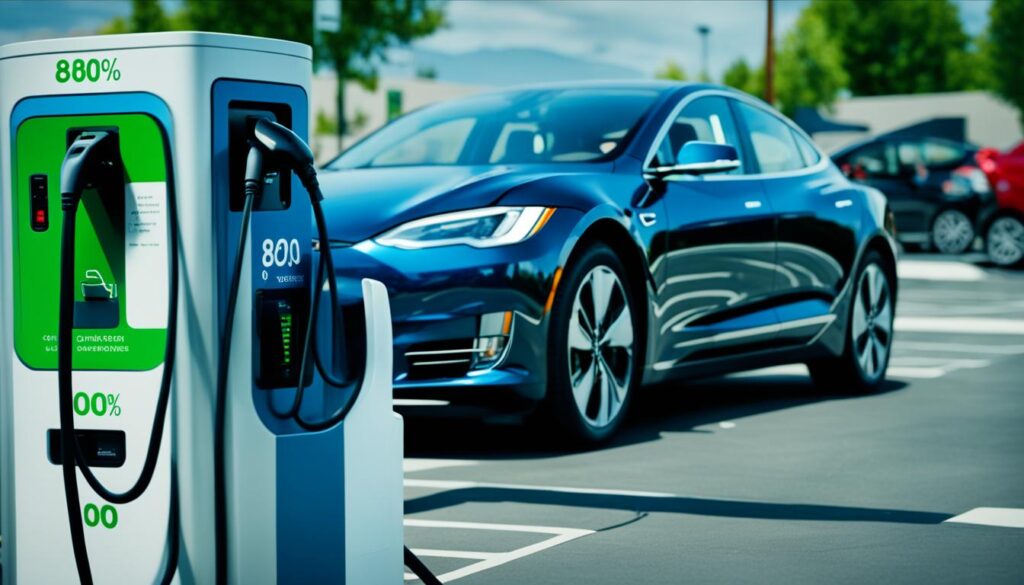
Personal Experiences and Recommendations
When it comes to EV charging, personal experiences can greatly influence charging strategies and recommendations. As an EV owner myself, I have found that the ideal charging approach often varies depending on individual preferences, available charging infrastructure, and driving needs.
For daily driving, many EV owners, including myself, opt to charge their vehicles to around 80%. This charging level strikes a balance between battery health and range requirements, providing sufficient mileage for most day-to-day activities. Charging to 80% is a commonly recommended practice that ensures optimal battery longevity.
However, it’s important to note that some EV owners may choose to charge their vehicles to higher levels based on their unique circumstances. This may include individuals with access to extensive charging infrastructure or those with longer commutes or travel requirements. In such cases, charging to higher levels, such as 90% or occasionally even 100%, can offer the necessary range without causing irreversible damage to the battery.
“For longer trips and the occasional need for extended range, I find that charging my EV to 100% provides the peace of mind and flexibility I desire. It allows me to confidently embark on long journeys without worrying about running out of charge. Additionally, with the advancement in battery technology and improved battery management systems, occasional 100% charging does not significantly impact the overall health of the battery.”
On the other hand, it is advisable to avoid regularly going below 20% or charging to 100% for everyday driving. Consistently discharging the battery below 20% can be detrimental to its overall health, while regularly charging to 100% can place unnecessary stress on the battery, potentially leading to degradation over time. By adhering to this advice, EV owners can strike a balance that maximizes their battery life and driving range.
To summarize, personal experiences and recommendations for EV charging strategies vary among owners. Charging to 80% for daily driving is a common practice that provides sufficient range. However, it’s important to consider individual needs, available infrastructure, and occasional deviations from this rule to optimize EV charging experiences. By finding the right balance between battery health and range requirements, EV owners can ensure a smooth, efficient, and enjoyable driving experience.
Factors to Consider in Charging Practices
When it comes to EV charging practices, there are several important factors to consider. These factors can impact not only the efficiency of charging but also the overall health and longevity of your EV battery.
Battery Management Systems
One crucial factor is the presence of a battery management system (BMS). BMS is designed to protect your battery from over-charging and over-discharging, ensuring its optimal performance and longevity. It constantly monitors the state of the battery and provides warnings or takes automatic actions to prevent any potential damage. The BMS plays a vital role in regulating the charging process, ensuring that the battery receives the appropriate level of charge without exceeding its limits.
“The battery management system acts as a guardian for your EV battery, safeguarding it from potential harm caused by improper charging.”
Charging Infrastructure
The availability of charging infrastructure also significantly influences your charging practices. The presence of a robust charging network, especially equipped with DC fast-chargers, can greatly impact the speed and convenience of charging. If you have access to fast-chargers, it allows for shorter charging times and more efficient charging sessions. This flexibility enables you to charge your EV up to a desirable level without spending excessive time at the charging station.
On the other hand, if fast-charging options are limited in your area, it may require you to adapt your charging strategy accordingly. You might consider planning your charging sessions in advance to ensure you charge your EV to an optimal level at home or other available charging facilities.
Finding the Right Balance
Considering the factors mentioned above, it’s essential to strike a balance between battery health and range requirements. Adapting your charging strategy based on these factors will help you optimize your charging practices. Ideally, you should follow the manufacturer’s recommendations and guidelines for charging your specific EV model.
Regularly monitoring your battery’s performance and health is also important. Keeping an eye on metrics like charging efficiency, range, and battery degradation will help you identify any potential issues and make informed decisions regarding your charging practices. Be proactive in addressing any concerns in a timely manner to ensure the long-term health of your EV battery.
“A well-informed and balanced approach to charging is vital for maximizing battery life and maintaining optimal performance.”
By considering factors such as battery management systems, charging infrastructure availability, and following manufacturer recommendations, you can establish an efficient and effective charging routine for your EV.
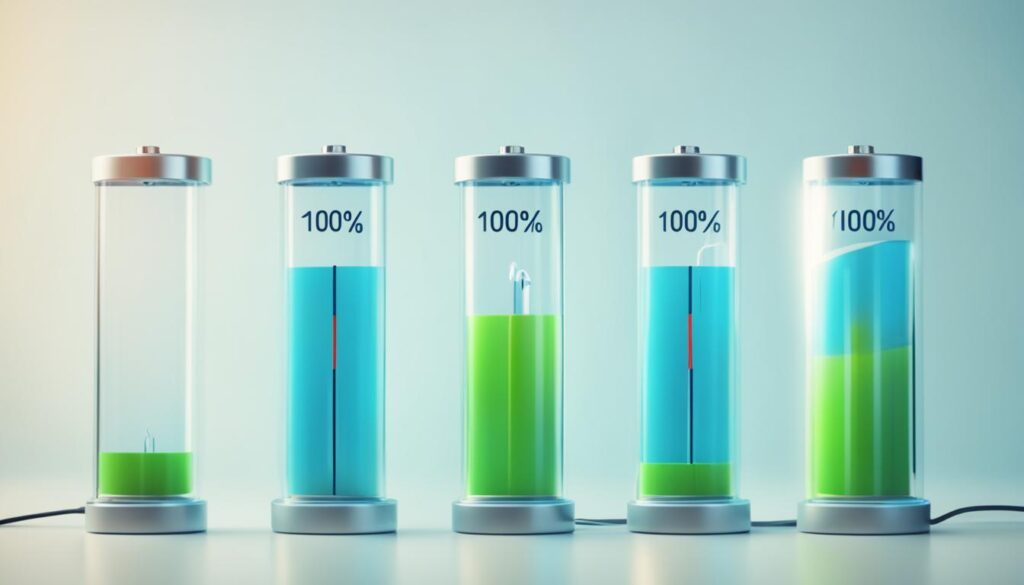
Conclusion
In conclusion, optimal charging practices for EVs involve charging to around 80% for day-to-day driving. Charging the battery to 100% every time is unnecessary and can potentially stress the battery, while allowing the charge to drop below 20% is also not recommended. The widely believed myth of the 80/20 rule does not hold true for EV batteries and is based on misinformation.
It’s important to note that different EV battery chemistries may have slightly different charging characteristics. For example, LFP batteries, which use iron and phosphorus instead of cobalt or nickel, may be charged to 100% more regularly. However, it’s important to bear in mind that LFP batteries are not suitable for larger battery packs and are less energy-dense.
As EV owners, we each have our own personal experiences and unique driving scenarios. Finding a balance between battery health and range requirements is crucial. By following manufacturer recommendations, regularly monitoring battery performance, and considering factors such as charging infrastructure availability, we can optimize our charging practices for both longevity and efficiency.





